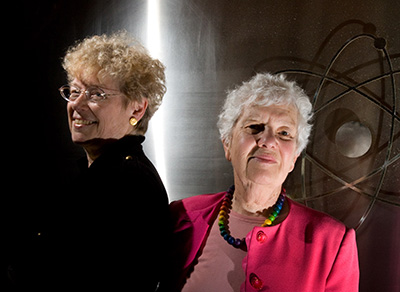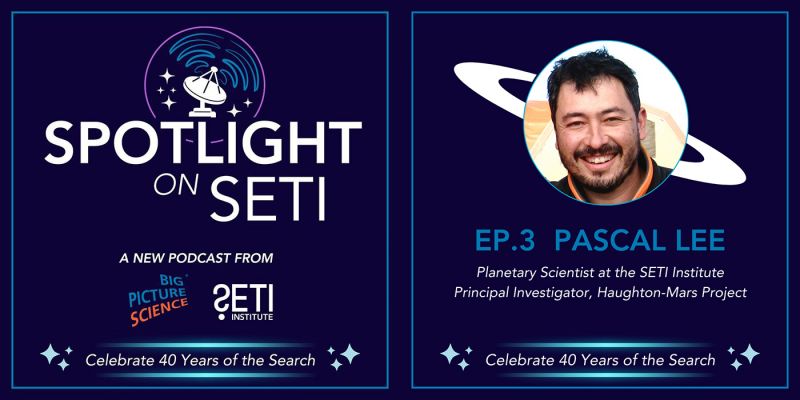
SETI Scientists Detect Mysterious Radio Bursts with Help from AI
Breakthrough Listen, a program to search for intelligent extraterrestrial communications, recently announced exciting results in an effort to apply machine learning to the challenge of signal detection. The team examined mysterious repeating light pulses called fast radio bursts, or FRBs. An algorithm called a “convolutional neural network” was applied to a large amount of data collected by the Green Bank Telescope on a particular emission, FRB 121102, the only one known to emit repeated bursts. While researchers who scoured the data collected in 2017 showed 21 bursts in their report, reanalysis with the algorithm revealed a stunning 72 additional bursts that were previously undetected.
The lead author of the paper announcing these results is UC Berkeley doctoral student Gerry Zhang, and co-author Dr. Andrew Siemion, Bernard M. Oliver Chair for SETI at the SETI Institute, Berkeley SETI Research Center Director and Breakthrough Listen Principal Investigator was quoted extensively following a SETI Institute press release about the findings. MSN emphasized the intriguing phenomenon’s unknown source:
"The nature of the object emitting them is unknown," SETI said, adding: "There are many theories, including that they could be the signatures of technology developed by extraterrestrial intelligent life."
Newsweek highlighted Dr. Siemion’s remarks on the potential machine learning holds for research:
"[Zhang's] work is exciting not just because it helps us understand the dynamic behavior of FRBs in more detail," remarked Berkeley Search for Extraterrestrial Intelligence (SETI) Research Center Director and Breakthrough Listen Principal Investigator Andrew Siemion, "but also because of the promise it shows for using machine learning to detect signals missed by classical algorithms."
And Science Daily noted that the data might eventually allow scientists to determine the origin of these mysterious bursts:
Just as the patterns of pulses from pulsars have helped astronomers constrain computer models of the extreme physical conditions in such objects, the new measurements of FRBs will help figure out what powers these enigmatic sources, Siemion said.
"Whether or not FRBs themselves eventually turn out to be signatures of extraterrestrial technology, Breakthrough Listen is helping to push the frontiers of a new and rapidly growing area of our understanding of the Universe around us," he added.
The SETI Institute has been applying machine learning to its work in a number of exciting initiatives, including using the IBM Cloud and AI algorithms to analyze signals identified by the Allen Telescope Array, and using the advantage of the ATA’s wide frequency coverage in combination with the IBM Cloud to conduct new types of observations on wide-band signals from exoplanets.
- MSN: Alien signals spotted from galaxy 3bn light years away
- Newsweek: FRBs: Dozens of Repeating Radio Signals Discovered Coming from Galaxy 3 Billion Light Years Away
- Science Daily: Artificial intelligence helps track down mysterious cosmic radio bursts
- Astrobiology Magazine: Artificial Intelligence Helps Breakthrough Listen Find New Fast Radio Bursts
- SETI.org: Artificial Intelligence Helps Find New Fast Radio Bursts
- Space.com: Mysterious Light Flashes Are Coming from Deep Space, and AI Just Found More of Them
- BGR: Scientists hear dozens of mysterious radio signals beaming through space
- RT: AI detects ‘mysterious repeating’ signals from ‘alien galaxy’ 3 billion light years away
- Sky News: SETI scientists spot 72 signals 'from alien galaxy' 3bn light years away
- ArXive: Fast Radio Burst 121102 Pulse Detection and Periodicity: A Machine Learning Approach
 There’s No Place like Home: What Earthlings Can Learn from Space Travel
There’s No Place like Home: What Earthlings Can Learn from Space TravelA recent editorial in the journal Science opens with the question: “How much of the planet should we leave for other forms of life”? However, meeting certain targets for contrived “protected areas” may not be the best approach. Nathalie Cabrol, astrobiologist and Director of the Carl Sagan Center for the Study of Life in the Universe at the SETI Institute, responded to the editorial in a Space.com article:
"Now we are talking about a bioengineered world, we are not talking about a planet anymore; we are talking about a national park on a planetary level and it's not a biosphere anymore," Nathalie Cabrol, an astrobiologist at the SETI Institute, told Space.com. "We are going to create an artificial bubble when what we had was a beautifully working natural system."
Cordoning off land into controlled environments may create problems, and the Space.com article touches on the troubled history of experiments in artificial biospheres. The challenge of creating manufactured habitats holds significant implications for space travel – if we cannot support life on Earth, the odds of doing so elsewhere appear grim. John Rummel, a former planetary protection officer at NASA and senior scientist at the SETI Institute, points out that artificial biospheres may be useful for research, but:
"Even at best, any biosphere that we could construct for centuries to come is going to be a mere shadow of what we have every day on the Earth," he said.
Rummel, who describes our planet as “a wonderland”, emphasized the peril of treating space travel as a refuge from the consequences of our behavior on Earth:
…if we continue to lose biodiversity here on Earth, space exploration may slip out of reach, Rummel said, as species losses ripple through food webs and cause accelerating change. "The very basis of the economies and support systems on the Earth that allow us to envision going elsewhere with both robots and people, those are the things that are in jeopardy."
Cabrol warns, "we are not going to fix any of the problems that we have on Earth by going to Mars," but goes on to suggest that there may still be valuable insight gained as we face the dangers of exploring inhospitable worlds such as the red planet:
"Maybe what Mars is going to give us is a consciousness of how beautiful, precious, fragile Earth is." Cabrol said. "We should not use planetary exploration as an escape."
 Stargazing in San Francisco: the eVscope Brings Amateur Astronomers and SETI Together
Stargazing in San Francisco: the eVscope Brings Amateur Astronomers and SETI TogetherOur eyes can only perceive distant nebulas dimly when viewed through conventional backyard scopes. Franck Marchis, senior planetary astronomer at the SETI Institute, teamed up with the start-up Unistellar to create the eVscope – an instrument designed to bring unparalleled viewing of the sky to amateur stargazers. Popular Science profiled Marchis and his work with Unistellar:
Marchis has been testing eVscope prototypes with nonprofessionals on Bay Area streets and at star parties. “Seeing color in a nebula from a garden in San Francisco?” he says. “That’s pretty cool.”
The instrument is compact and uses light amplification to accumulate light, resulting in images similar to those normally seen in larger, advanced research telescopes. It also features GPS allowing users to target a specific celestial object autonomously. You can learn more about Franck Marchis and his work with Unistellar on our website, SETI.org.
- Popular Science: Franck Marchis is connecting amateur astronomers to extraterrestrial researchers
- SETI.org: SETI Institute-Unistellar Partnership Promises to Revolutionize Amateur Astronomy
 SETI Astronomer Seth Shostak on Simulation
SETI Astronomer Seth Shostak on SimulationSeth Shostak, senior astronomer at the SETI Institute gave an interview on Simulation, a show devoted to “rebirthing the public intellectual” through multidisciplinary perspectives and nuance questions. Topics ranged from Shostak’s work as an “alien hunter”, to his own show, Big Picture Science, a radio show and podcast produced at the SETI Institute’s headquarters in Silicon Valley. Listed for a lively and wide-ranging conversation about the work of SETI and what we’ve learned about our universe so far.
- YouTube: Simulation #187 Dr. Seth Shostak - Search for Extraterrestrial Intelligence
- SETI.org: "Big Picture Science" radio and podcast program overview
 Sandra Faber, Former SETI Institute Trustee, Supports Diversity in Astronomy through UC Santa Cruz Endowment
Sandra Faber, Former SETI Institute Trustee, Supports Diversity in Astronomy through UC Santa Cruz EndowmentSandra Faber, Trustee Emeritus of the SETI Institute, helped to launch a campaign for the Vera Rubin Presidential Chair for Diversity in Astronomy, a $1.5 million endowment gifted to UC Santa Cruz. Faber joined the SETI Institute’s Board of Trustees in 1996 and served for many years. Faber and her husband contributed significant funds to the endowment, which will use the proceed to enhance UC Santa Cruz’s Department of Astronomy and Astrophysics ability to draw underrepresented groups into its programs.
In last week’s episode, enjoy an encore of Angles of a Hack, part two of BiPiSci’s look at the history and future of hacking. On our previous week’s episode, discover the origins of modern-day hacking in an encore of Plan of a Hack.
Last week on Facebook Live, Dava Newman, Nathalie Cabrol, and Jaya Bajpayee are interviewed by SETI Institute CEO Bill Diamond in a preview of their SETI Talk panel discussion on human exploration of Mars. On our previous episode of Facebook Live, SETI Institute scientist Kathryn Bywaters discussed her work in life detection instrumentation with CEO Bill Diamond. Videos of all past Facebook Live events can be found on our Facebook page: https://www.facebook.com/SETIInstitute/
- Star and Planetary System Formation in the Age of ALMA: September 19, San Francisco, CA SETI Institute scientist Mary Barsony will present
- UC Berkeley Astronomy Colloquium: September 20, Berkeley, CA SETI Institute Senior Scientist Matthew Tiscareno will offer a talk about Cassini’s grand finale
- Sedgwick Bicentenary Meeting: September 22, University of Cambridge, U.K. Seth Shostak, Senior Astronomer at the SETI Institute will be one of the speakers
- Amateur Astronomers Association of New York Starfest: September 22, New York, NY SETI Institute Senior Scientist Franck Marchis will demonstrate the Unistellar eVscope
- XVIth Hvar Astrophysical Colloquium: September 24-28, Hvar, Croatia Meng Jin, SETI Institute Research Scientist will be one of the invited speakers; his presentation is "Sun-to-Earth Modeling of CMEs with a Global MHD Model: Facilitating Physical Understanding and Space ins
- NASA Technosignatures Workshop: September 26-28, Houston, TX SETI Institute President & CEO Bill Diamond, and Bernard M. Oliver Chair for SETI at the SETI Institute Andrew Siemion will participate
- Becoming Interplanetary: September 27, Washington, D.C. Nathalie Cabrol, Director of the Carl Sagan Center at the SETI Institute will be part of this event at the Library of Congress
- Institute of Geophysics and Planetary Physics: September 28, Santa Cruz, CA SETI Institute scientist JR Skok will give a talk about the search for life in the Martian Hot Springs
- The World Above the Tetons Science Speaker Series: September 29, Teton Village, WY Jill Tarter will present Communicating Beyond Earth
- International Astronautical Conference: October 1-5, Bremen, Germany John Rummel, Senior Scientist at the SETI Institute will be chairing a session
- Maria Mitchell Women in Science Symposium: October 5-6, Wellesley, MA Jill Tarter will be a keynote speaker
- Wired 25th Anniversary Festival: October 12-15, San Francisco, CA Jill Tarter, co-founder of the SETI Institute, will take part in the festival and present "The 21st Century: The Century of Biology on Earth and Beyond"
- Fermilab Arts and Lecture Series: October 12, Batavia, IL Jill Tarter, SETI pioneer and Chair Emeritus for SETI Research at the SETI Institute will present
- Kepler, K2, TESS and Beyond: October 24, Bremerton, WA Jeff Coughlin, SETI Institute scientist and Director of the K2 Science Office, will giving a public talk at Olympic College in Bremerton, WA.





